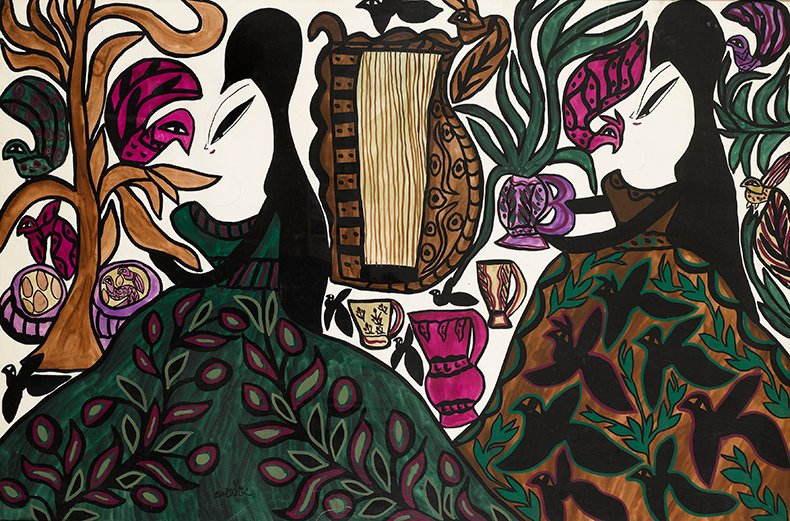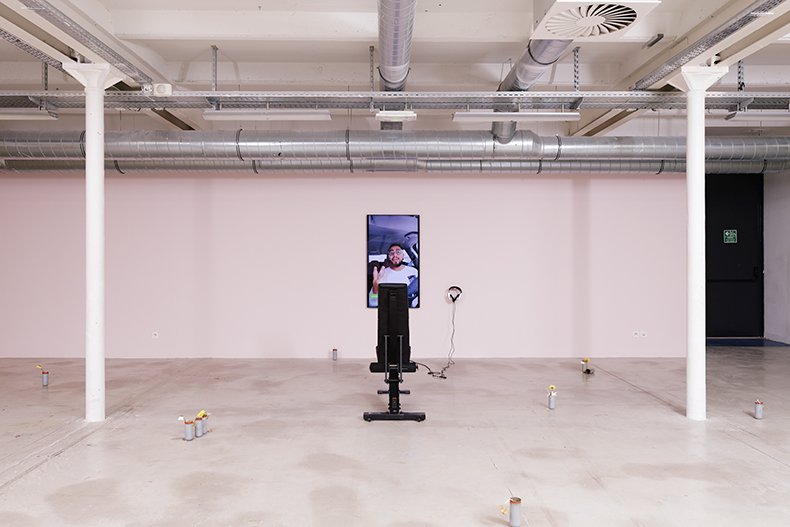The Algerian artist Baya was just 16 when she had her first exhibition at the Galerie Maeght in Paris, bringing her to the attention of the Surrealists, for whom she was made into an emblem of art naïf. The startling beauty of Baya’s paintings, bright, balanced, brimming with flowers and butterflies and sharp-eyed women, might cause us to mistake them for ease. Picasso certainly did, grumbling with some resentment about her childlike creativity when he worked in a ceramics studio alongside her in 1948.
However, an exhibition at the Vieille Charité in Marseille – first shown in Paris at the Institut du Monde Arabe – complicates this story, alternating between an exploration of Baya’s sources and an account of her reception in Paris. Born in 1931 as Fatima Haddad, Baya took her mother’s name after her death. She was eventually taken under the wing of the French amateur artist Marguerite Caminat Benhoura and began drawing with materials she found around the house. Benhoura nurtured her talents and introduced her to others who marvelled in Baya’s fresh colours and fantastical motifs.

Femmes et cithare (1966), Baya. Courtesy Ville de Marseille
The inclusion in the exhibition of Kabyle garments, terracotta children’s toys and silver jewellery helps to contextualise Baya’s influences and impressions, lending weight to the patterns that animate her paintings. On the other hand, a photograph of her published in Vogue in 1948 gives a sense of how rapidly her work was integrated into existing narratives – this wasn’t just about art, but about the possibility for happy Franco-Algerian relations at a time when war was on the horizon. Studies for two unrealised publishing projects, both interrupted by the violence of the so-called ‘black decade’ in post-independence Algeria, are a reminder of how heavily Baya’s work was mediated by the political circumstances of the time.
Similarly, an Algerian postage stamp from 1969 reproducing her painting of a mother and child put her in the service of a nationalism founded on family values. Baya’s exceptional status as a self-taught female Algerian artist who achieved international renown means her art was often made to speak for things well beyond herself; the success of the show in Marseille is, to some degree, returning it to its own terms.
Across town, another exhibition presents a different angle on artists’ often uncomfortable relationship with the country in which they work. ‘Ni drame ni suspense: Les conditions de la durée’ is a group show of young artists who were offered studios by the city of Marseille. The exhibition’s unspoken leitmotif is the derelict condition of those city-sponsored studios. Many of the artists gather from the streets the materials they need to make an art of excavation as much as presentation. Held in the sprawling former SEITA cigarette factory, transformed into an art incubator known as La Friche du Belle de Mai, even the exhibition space is a testament to the afterlives of abandoned structures.
One piece, in particular, resonates with the Baya exhibition, if in very different tones. Samir Laghouati-Rashwan gathered tear gas canisters from the aftermath of one of many demonstrations in Marseille’s streets. Repurposing them as vases holding found flowers, they sit in dialogue with a video produced using the now-defunct social media app, Periscope. Laghouati-Rashwan used the app to ask about ‘la loi du plus fort’, the presumed governing mantra of Marseille’s housing estates. The person-to-person format allows for a seemingly more direct line of communication that Baya ever had, but the results are strangely similar. As Alice Kaplan has pointed out, Baya often responded ‘I don’t know’ to questions that tried to pigeonhole her work. And here, the interviewees largely refuse to affirm stereotypes about the rule of might in Marseille’s supposedly lawless ‘Northern Quarters.’ We see instead the banalities of everyday life, the myriad ways of being in the world; ‘all the cités [housing estates] are different,’ one interviewee claims.

Installation view of La Loi du Plus Fort (2020), Samir Laghouati-Rashwan, in the exhibition ‘Ni Drama Ni Suspense’ at the Friche la Belle de Mai, Marseille, in 2023. © Samir Laghouati-Rashwan
The context of recent riots in the city following the police shooting of Nahel Merzouk, a teenager of Algerian descent who came from the same kind of cité as those at issue in the video, makes both exhibitions’ subtle engagement with the still ongoing consequences of colonialism all the more pressing. At a time when identity seems to define so much of politics, allowing for more nuanced subjects may be one path out of social divisions that feel increasingly intractable.
‘Baya: An Algerian Heroine of Modern Art’ is at the Vieille Charité, Marseille, until 24 September.
Source : https://www.apollo-magazine.com/baya-algerian-painter-marseilles-review/






